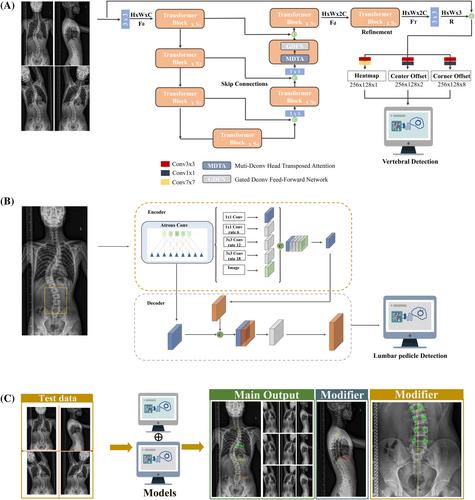Automatic Lenke classification of adolescent idiopathic scoliosis with deep learning
Abstract
Purpose
The Lenke classification system is widely utilized as the preoperative evaluation protocol for adolescent idiopathic scoliosis (AIS). However, manual measurement is susceptible to observer-induced variability, which consequently impacts the evaluation of progression. The goal of this investigation was to develop an automated Lenke classification system utilizing innovative deep learning algorithms.
Methods
Using the database from the First Affiliated Hospital of Sun Yat-sen University, the whole spinal x-rays images were retrospectively collected. Specifically, images collection was divided into AIS and control group. The control group consisted of individuals who underwent routine health checks and did not have scoliosis. Afterwards, relative features of all images were annotated. Deep learning was implemented through the utilization of the key-point based detection method to realize the vertebral detection, and Cobb angle measurement and scoliosis classification were performed based on relevant standards. Besides, the segmentation method was employed to achieve the recognition of lumbar vertebral pedicle to determine the type of lumbar spine modifier. Finally, the model performance was further quantitatively analyzed.
Results
In the study, a total of 2082 spinal x-ray images were collected from 407 AIS patients and 227 individuals in the control group. The model for vertebral detection achieved an F1-score of 0.809 for curve type evaluation and an F1-score of 0.901 for thoracic sagittal profile. The intraclass correlation efficient (ICC) of the Cobb angle measurement was 0.925. In the analysis of performance for vertebra pedicle segmentation model, the F1-score of lumbar modification profile was 0.942, the intersection over union (IOU) of the target pixels was 0.827, and the Hausdorff distance (HD) was 6.565 ± 2.583 mm. Specifically, the F1-score for ultimate Lenke type classifier was 0.885.
Conclusions
This study has constructed an automated Lenke classification system by employing the deep learning networks to achieve the recognition pattern and feature extraction. Our models require further validation in additional cases in the future.


 求助内容:
求助内容: 应助结果提醒方式:
应助结果提醒方式:


